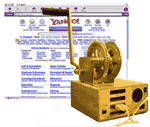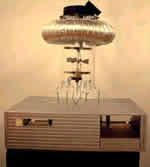|
Crank the Web
 Crank
the Web is a browser that allows people to physically crank their
bandwidth in order to see a web site. The idea behind Crank the
Web is that all bandwidth should be free and everyone should have
access to the fastest speed connection. It is up to every single
user to physically crank their bandwidth so that their internet
connection will rely on their personal strength rather than their
personal wealth. Users type in a URL on the screen and hit ENTER
and a blank browser page appears. The page they entered is read
into a buffer. Using the crank, they send a bit of data at a time
to the computer which unloads the buffer (containing text, images,
animation, sound, etc.) into the open window. The page loads according
to how fast they turn the crank. Jonah Brucker-Cohen won the Fourth
International Browser Day 2001 with Crank the Web. Crank
the Web is a browser that allows people to physically crank their
bandwidth in order to see a web site. The idea behind Crank the
Web is that all bandwidth should be free and everyone should have
access to the fastest speed connection. It is up to every single
user to physically crank their bandwidth so that their internet
connection will rely on their personal strength rather than their
personal wealth. Users type in a URL on the screen and hit ENTER
and a blank browser page appears. The page they entered is read
into a buffer. Using the crank, they send a bit of data at a time
to the computer which unloads the buffer (containing text, images,
animation, sound, etc.) into the open window. The page loads according
to how fast they turn the crank. Jonah Brucker-Cohen won the Fourth
International Browser Day 2001 with Crank the Web.
Jonah Brucker-Cohen received an MPS from the Interactive Telecommunications
Program at New York University, NYC. Currently he is working at
MIT Media Lab Europe, Dublin. He is a freelance writer for such
magazines as Wired, I.D. Magazine or Time Out New York.
http://www.coin-operated.com/projects
LIVEWINDOW
LiveWindow is a project that attempts to translate the physicality
of the real world into the virtual. By viewing LiveWindow on the
web, a visitor can see a visual representation of the state of the
physical space at any time. On the physical side, the designer is
wiring a space to detect the vibrations of the floor. These concussions
are then relayed to a browser window which can be accessed via Internet.
If the room senses vibration, the window begins to shake, and its
text falls down. LiveWindow also works with other inputs: a light
sensory for ambient light changes the background color of the window,
a microphone picks up room volume and changes the size of the window,
and the amount of movement in the room causes the window to move
around accordingly.
LIVEWINDOW is one of the Physical Web Interfaces projects by Jonah
Brucker-Cohen and was designed in 2001.
http://www.coin-operated.com/projects
SearchEngine
 SearchEngine
is a physical search engine interface. By pulling the motor starter
cord, search terms are pulled live from the Internet and projected
onto the wall as a rising cloud of fake exhaust fumes. SearchEngine
is the sixth installment of Jonah Brucker-Cohen's Physical Web Interfaces
projects. The idea is to fully realize the concept of the search
engine by actually connecting the process of starting a real engine
with the experience of searching the web. Instead of finding results
from a search, this engine produces the very terms that are pulled
directly from a live source on the web. The artist wanted to turn
the metaphor of "search engine" back onto itself and see
what it really meant to use a real engine that conducted searches.
The system is a physical installation made of plexi-glass tubes,
an old PC computer case, a DC motor, and a PIC16F84A chip that communicates
serially with the computer and the motor, and reads in the switch
information. SearchEngine
is a physical search engine interface. By pulling the motor starter
cord, search terms are pulled live from the Internet and projected
onto the wall as a rising cloud of fake exhaust fumes. SearchEngine
is the sixth installment of Jonah Brucker-Cohen's Physical Web Interfaces
projects. The idea is to fully realize the concept of the search
engine by actually connecting the process of starting a real engine
with the experience of searching the web. Instead of finding results
from a search, this engine produces the very terms that are pulled
directly from a live source on the web. The artist wanted to turn
the metaphor of "search engine" back onto itself and see
what it really meant to use a real engine that conducted searches.
The system is a physical installation made of plexi-glass tubes,
an old PC computer case, a DC motor, and a PIC16F84A chip that communicates
serially with the computer and the motor, and reads in the switch
information.
SearchEngine is another one of the Physical Web Interfaces projects
by Jonah Brucker-Cohen and was designed in 2001.
http://www.coin-operated.com/projects
Site_Traffic V1.0
Site_Traffic is a telepresence project that involves both a physical
installation and a web-based interface component. The project functions
as a fully programmable remote sequencer that allows for unique
non-verbal communication between users in physical and online spaces.
Since Site_Traffic's programming interface lives online, the installation
is best realised over time. By placing the physical device in a
well-trafficked public space, repeat users can see the change in
songs left by users of the project's internet component. Users online
can program unique MIDI sequences and put them on one of the buttons.
These can then be transformed and listened to by users in the physical
space.
Site_Traffic V1.0 is one of the Physical Web Interfaces projects
by Jonah Brucker-Cohen and was designed in 2000.
http://www.coin-operated.com/projects
|

